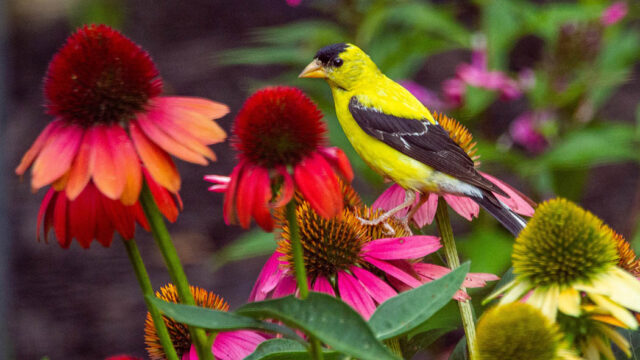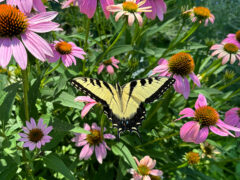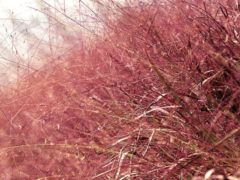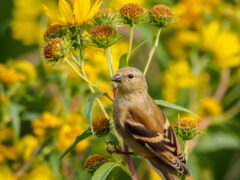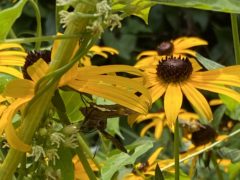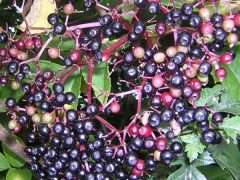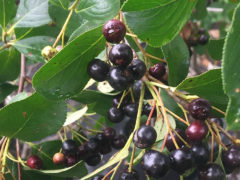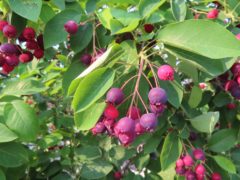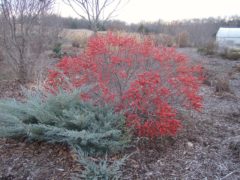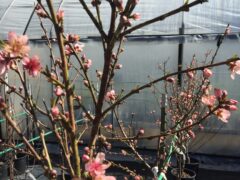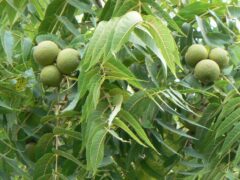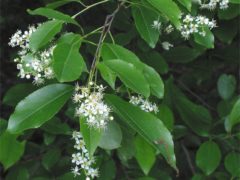Following is a short list of perennials, shrubs, and trees to feed fruit and seed-eating birds in fall and winter. Leave dried plant stalks in place until spring.
purple coneflower
Echinacea purpurea
Showy purple flowers in July and August on plants that grow to 2-3'. Like its cousins, flowers make great cuts, butterflies are attracted to the flowers and birds appreciate the seed when cones are left to dry.
purple love grass
Eragrostis spectabilis
Masses of reddish-purple panicle blooms are beautiful in large sweeps. [gallery link="file" columns="1" size="medium" ids="6089"]
oxeye daisy, false sunflower
Heliopsis helianthoides
Bright yellow daisies open in late summer thru fall on tall native plants. Tolerates some light shade, but plants are less vigorous and stems need support. Remove spent flowers to extend bloom season, but allow some seed to fall to encourage seedlings to grow and replace the short-lived perennial parents. Plant stems may be cut back by 1/3 to 1/2 in late May to reduce overall plant height while preserving fall bloom.
black-eyed Susan
Rudbeckia hirta
Huge 3-4″ deep yellow blooms with dark brown eye cover this black-eyed Susan from late spring until frost in an exuberant show. A rampant self-seeder, one plant will quickly become many in the garden. We leave ours to dry and provide birdseed in winter. Plants grow 30-36″ tall and tolerate a small amount of shade.
elderberry
Sambucus canadensis
Elderberries are super easy to grow, good for your health and great for wildlife. These adaptable native woody plants will colonize and spread unless shoots are removed periodically. White flower clusters in spring are followed by dark purple berries. Plants are self-fertile. 'York' offers the largest berries of any cultivated variety. Great source of vitamin C. Fruit makes wonderful pie, juice, jelly and wine. Vigorous and hardy plants produce showy white flowers in summer and colorful fall foliage. One of the easiest berries to grow, plants grow large—allow for 6 feet of width and a height of 8'. 'Adams' is known for its consistent yield and adaptability, making it another gardener’s favorite. Excellent for the wildlife garden as well. The elderberry is a host plant for over 40 species of butterflies and moths, including the cecropia moth, North America's largest moth. The elderberry's dark purple berries are eaten by up to 45 species of birds, including eastern bluebirds, northern cardinals, and mockingbirds. The elderberry provides nesting materials for native bees, and the hollow stems of older elderberry plants provide overwintering sites for bees.
black chokeberry
Aronia melancarpa var. 'Elata’
An open, upright, deciduous shrub that typically grows 3-6’ tall. Autumn berries and purple-red foliage color. Native to swamps and low woodlands from Newfoundland to Minnesota south to Tennessee and South Carolina. Var. elata is more vigorous, slightly larger but less suckering, with longer leaves, larger flowers and larger fruit, and is thusly considered to be a superior landscaping shrub in comparison to the species.
Allegheny serviceberry
Amelanchier laevis
A small, deciduous, usually multi-trunked understory tree or tall shrub which is native to thickets and open woods in Eastern North America where it typically grows 15-25’. Showy, 5-petaled, slightly fragrant, white flowers in drooping clusters which appear in early spring followed by edible berries loved by birds.
Larval host for the Striped Hairstreak butterfly.deciduous holly
Ilex verticillata
A profusion of striking bright red berries will stop you in your tracks on your winter hike and provide food for overwintering birds. Use as foundation color, for a natural hedge, or in a shrub border for a showstopping display. 'Red Sprite' ' is an excellent selection, and a male pollenizer such as 'Jim Dandy' is required for berry set. In addition to their striking ornamental value, deciduous holly berries provide food for at least 48 bird species. While the berries are low in fat content, they provide a valuable source of food in the winter, when other sources of food are scarce.
crabapple
Malus hybrids
A genus of about 35 species of deciduous trees and shrubs from Europe, Asia and North America. Adaptable to a wide variety of soil and light, good resistance to the main diseases of crabapples including apple scab, fire blight, rusts, leaf spot and powdery mildew. Insect pests are of lesser concern. Blooms in spring. Hardy to zone 4. ‘Indian Summer’ (pink/orange berries) 15-20’ tall and wide ‘Prairiefire’ (dark pink) 15-20’ tall and wide with purple foliage 'Royalty' (dark red) 18-20' tall and wide with purple foliage ‘Sargent’s (white) 6–10 ft tall and 6–12 ft wide ‘Sargent’s Tina’ (white) 5’ tall and 6’ wide ‘Sugar Tyme’ (white) 14-18’ tall and 11’–15’ wide 'Harvest Gold' (white with gold berries) 18-20' tall and 15' wide 'Louisa' (weeping, pink-flowered) matures to 12-15' tall and as wide All of the above cultivars are recommended by Kansas Roots, a service directory that aims to help gardeners make research-based plant decisions. K-State Research and Extension specialists have tested many varieties for their hardiness and growth potential.
black walnut
Juglans nigra
When grown in the open, the black walnut reaches 75' tall with a round, low branching, open crown that spreads nearly as wide as it is tall. It develops a deep taproot and is difficult to transplant. The hard-to-crack shell encases a nut, and shells can stain fingers, clothing, and concrete. The trees bear in 12-15 years. Partially self-fertile, plant multiple trees to ensure pollination. Alleopathy is the term given to the suppression of growth of one plant species by another due to the release of toxic substances. Black walnut tree roots contain juglone, a toxic substance released when the roots of juglone-sensitive species come in contact with walnut roots. The black walnut's poison does not work on all species and some even seem to thrive on it. Black walnut trees provide valuable winter food to birds and small mammals. It's a larval host plant for the Banded Hairstreak butterfly.
black cherry
Prunus serotina
This native ranges from southeastern Canada through the eastern US, and west to Texas. White flowers open after the glossy leaves have emerged, and dark red fruit changes to black from August through October. Fall foliage is yellow. According to the Lady Bird Johnson Wildflower Center, the fruit of the black cherry tree is eaten by 33 species of birds and many mammals, and is a larval host to Eastern Tiger Swallowtail, Cherry Gall Azure, Viceroy, Columbia Silkmoth, Promethea Moth, Small-eyed Sphinx Moth, Wild Cherry Sphinx Moth, Banded Tussock Moth, Band-edged Prominent, Spotted Apatelodes.
white oak
Quercus alba
Occurs in dry upland slopes and lowland valleys. Grows to 50-80’ tall in cultivation and up 100’ in the wild. Pyramidal when young, but matures into a substantial tree with a wide-spreading, rounded crown. Variable fall color ranges from uninteresting browns to quality shades of dark red. White oak grows over much of eastern North America and is an important hardwood timber tree.
Oaks are without doubt one of the most important trees of the Northern Hemisphere. Historically, oaks have been an important source of fuel, fodder, and building materials throughout their range. Acorns are a keystone plant providing an important wildlife food source. Acorns top food preference list for blue jays, wild turkeys, squirrels, small rodents, whitetail deer, raccoons and black bears.